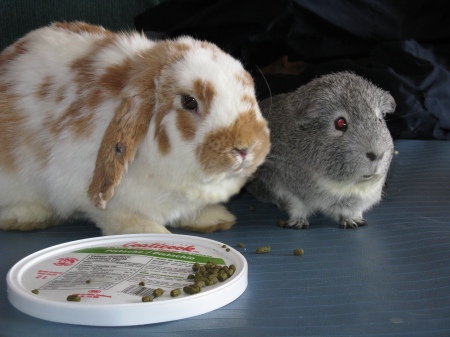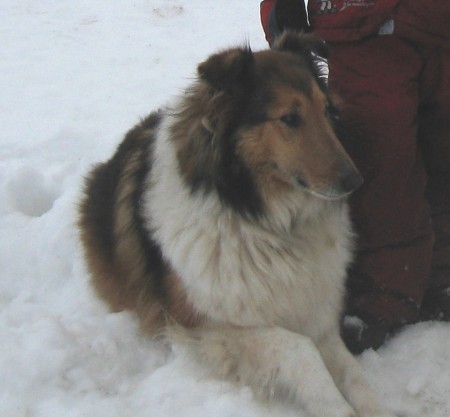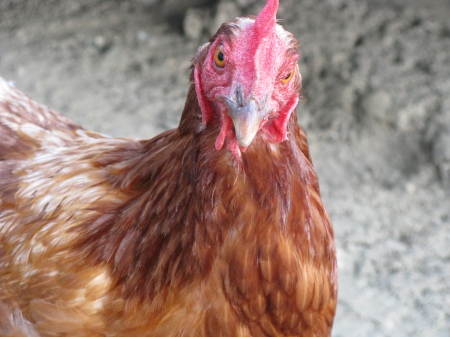I’m still trying to get a hang of this blog thing; if I were quicker and wrote shorter entries, stuff that just flies off the brain and into the computer and goes right to the point, I’d be better at this.
OK, I’ve been busy with paid work, for which I’m duly grateful, and with keeping the house warm as it’s been hovering around -20 for the past several days – no, make that weeks.
On one of those day back in January, I went out to the barn to check on the guineas, rabbits, chickens and barn kitties, I noticed that Pigma, our chief guinea pig, was looking a little low. That’s a subjective call, because guinea pigs aren’t very expressive creatures. The range of symptoms they might show for severe illness is: “no thank-you, I won’t be having any parsley today”; and the next thing you know they’re pining for the pampas. To be honest, my son had asked me to take a look at him because he was vaguely concerned, so I can’t say I was being particularly observant.
 Pigma is the grey fellow on the right.
Pigma is the grey fellow on the right.
I had Pigma neutered by one of my colleagues back in November, mainly because the novelty of guinea babies had worn off. After something like 7 litters with anywhere between 2 and 6 babies each time, we’d seen enough. Guinea fertility is even more spectacular than rabbits, especially as their mating is that much more discreet. I never saw a single mating, but I saw the results too many times to count. Part of this was my fault: in spite of some excellent and very detailed information available on the internet, my sexing rate for young guineas before the age of two months is still only about 50%, whereas Pigma’s stands at a perfect 100%. So the young females I mistook for males ended up having litters; and a young male guinea I mistakenly placed with our two females was also remarkably precocious. We’ve also had a few logistical accidents, like last summer when the dividing wall in the temporary cage was breached, from both sides. A local pet shop has been happy to take in our accidents; since I wasn’t doing this for money, I was just happy that someone else wanted them.
I didn’t neuter Pigma myself since I don’t normally do surgery, and my colleague had carefully researched the procedure and was willing to take it on. We discussed the special risks of anaesthesia for guineas, as well as the increased risk of infection compared to other species we’re more familiar with. Pigma pulled through the very short surgery very well, and I kept him in the house for a couple of weeks before sending him out to more space with the three females in a protected space in the barn. He was doing well, or so I thought, based on his healthy appetite. But when I picked him up that day back in early January, there was a very large, firm mass hanging off his lower belly.
I brought him back inside, and observed him for a day or so – his appetite was excellent as usual, though his weight was down to 1.5 pounds from a high of 3 just before surgery. I hoped the mass wasn’t a hernia (i.e. the holes left from the castration not healing properly leaving the abdominal contents to spill out and sit there just under the skin). That would mean another surgery, more delicate this time, and the mass was so big it looked disastrous for a hernia. His ears were warmer than normal, and his eyes a bit teary, so an abscess was also a distinct possibility. Proof of that was easily obtained by siphoning out some liquid with a needle and syringe – the mass was a clementine orange-sized ball of pus.
Normally, abscesses are an extremely gratifying condition to treat, I see them regularly at the clinic in cats who don’t like other cats (bite wounds leading to abscess): you lance the mass with a small scalpel, empty it out to the last drop of evil-smelling liquid while everyone around you goes pale or leaves the room, then flush with saline and disinfect and prescribe antibiotics and a painkiller, either orally or by injection. The antibiotics in the penicillin family are usually the best because they have an excellent penetration of pus-filled capsules and they kill bacteria rather than simply prevent their spreading.
The problem with guinea pigs is that their digestive tracts are an Amazonian ecosystem of sensitive but highly specialised bacterial and protozoal life. When you give them penicillin-type antibiotics, you’re burning down the rainforest; the remedy can do more damage than the infection you’re trying to eliminate, and your guinea pig may die from malnutrition.
Armed with this knowledge – and trying not to think about how that knowledge was obtained – I gave Pigma a 10-day course of antibiotic treatment with Baytril, a common veterinary antibiotic that has been generally OKed for use in guineas and various other small mammals. Apparently, Baytril causes hallucinations in humans, which is why we don’t use it on ourselves; but I wasn’t game enough to sample any more than a few drops. The taste was not good, and apparently not improved when mixed with blueberry jam, carrot juice or any other vegetable. Pigma put up a typical guinea pig protest to the treatment, a short, ineffectual struggle followed by passive resistance and a few disgruntled chuckles while I fed him with the dropper. It’s easy to see how guinea pigs became a great favourite of scientists by the late 1960s, which was when they hit their peak in lab-room popularity: they are some of the gentlest and most placid animals you’ll ever meet, they rarely bite, though they can easily draw blood when they do; and they pretty much stay put wherever you set them down unless they spot something nearby to hide under (probably their atavistic reflex of avoiding swoop-downs from hawks). They also cohabit very peacefully, even among males, and they seem to have some kind of well-developed language that they use which reduces physical confrontation. But since the 1980s, guinea pig numbers in labs have dropped dramatically; they’ve been replaced by mice and rats, which have less tricky digestive requirements – e.g. unlike many domestic mammals, guineas can’t produce their own Vitamin C, so they can get scurvy just like us; also, many of their proteins, such as insulin, are genetically very different from both humans and mice. So they really aren’t that useful as experimental subjects after all – unless you want to know more about guinea pigs themselves, and that was never the point of the research anyways.
So the Baytril went down well with the digestive system, but it wasn’t much help in solving the problem. Ten days of force-feeding Baytril-laced blueberry jam all for nothing (I’m so sorry, Pigma 😦 ). The abscess was still there; every day I squeezed out varying quantities of cheesy pus with no sign of improvement, and Pigma kept telling me that it hurt when I squeezed.
In some domestic animals, an option to consider with an abscess that won’t heal is to place a drain in the skin so that the pus can evacuate instead of collecting and festering, though of course, you have to make sure the animal can’t tear it out and chew it up. But that won’t work in guinea pigs because the pus is often caseous (cottage cheese-y) and won’t drain properly.
I figured I had two options left. One, flush the abscess with some kind of disinfectant, hopefully something mild enough to not cause pain or irritate the tissues that help in fighting and healing the infection; or I could inject some penicillin directly into the abscess cavity and hope for the best – that little or none would be absorbed into the bloodstream and sent to the intestines. I figured number two was a less painful option, and as I had tried it once in a cow a few years ago and it worked, I figured the benefits outweighed the risk.
The penicillin itself is mild enough chemically, not painful and irritating to the tissues, so Pigma didn’t object too much to the flushing. But by the next day, I could already tell that enough of it had been absorbed into his bloodstream: for the first time in his life (except for the day we brought him home from the pet store) he refused to eat his favourite vegetables, carrots, broccoli, red pepper and lettuce. Not even parsley would bring him out of his hiding spot.
Therapeutic failure is something I always take personally. I felt bad for Pigma, down on myself for making the wrong decision, and sorry for letting my son down. Of all our animals, he’s especially attached to Pigma, who was his choice of present two years ago on his 9th birthday. I had breezily assured him back in November that Pigma’s castration would be no problem at all. Even though it had been at least two months, it was pretty obvious from the location of the abscess that the surgery was the source of the infection.
Pigma was off his food for four long days; every day at noon I cleaned out his rear end: instead of making his normal firm, tidy, thin-nuggets, he was producing a smelly mass of unfamiliar fecal matter that he couldn’t even evacuate by himself. I didn’t do this first thing in the morning, because guinea pigs, like rabbits, eat their own stool during the night: their hindgut bacteria produce vitamin B and other vitamins and nutrients that they then have to re-ingest so that it can be absorbed in the first part of the intestine. I didn’t want to interfere with that process in addition to the damage I’d already done…
But on the fourth day, Pigma quietly accepted a few celery leaves, then some spinach, and some choice pieces of red pepper. Slowly, to my relief, his appetite was returning to normal; and best of all, the abscess had suddenly started to heal properly. The penicillin had done its job, in spite of the collateral damage. I hadn’t wiped out the entire ecosystem after all.
I keep checking him to see if the abscess is coming back, but it’s been several days and no sign of the smallest bump. I probably won’t send him back outside until spring though.
In the interest of being a pedant amateur historian, I need to add a few things. First of all, guinea pigs are (of course) not remotely related to pigs. In fact, they are barely even rodents, though I see they’re still hanging off a branch that’s loosely attached to that order of mammals, along with fellow New World creatures like the capybara and the lovely mara.

They are usually called “cavies” by people who really know and love them well. They do not come from Guinea either; I imagine the confusion first arose when they were introduced to England in the late 1500s, during the first brutal takeover of the Americas. Introduced to England by the Dutch, the ladies in the court of Queen Elizabeth I thought they were adorable and carried them around on silk pillows. Cavies could be bought for a guinea in later centuries, and many people came to believe they were originally from Guinea (Africa) – due to the triangular slave and goods trade between Europe, Africa and the Caribbean.
Thinking about guinea pigs and their history, intertwined with the human history of enslavement, despoilation and elimination of peoples and ecosystems, awakens in me the usual pangs of guilt and sadness for what could have been, instead of what we know has happened. Guinea pigs themselves are a byword for cruel and invasive expermentation on defenceless bodies that are utterly unequipped to resist. Some of that experimentation and despoiling may have been blind and unintentional, or with a (misguided) intent to serve a greater good. Much of it though, was and is still based on greed, short-sightedness and a rapacious desire for temporary and ill-defined success. I wish we could learn better from history, but it doesn’t look like we’re all trying to learn the same lessons.




 Pigma is the grey fellow on the right.
Pigma is the grey fellow on the right.